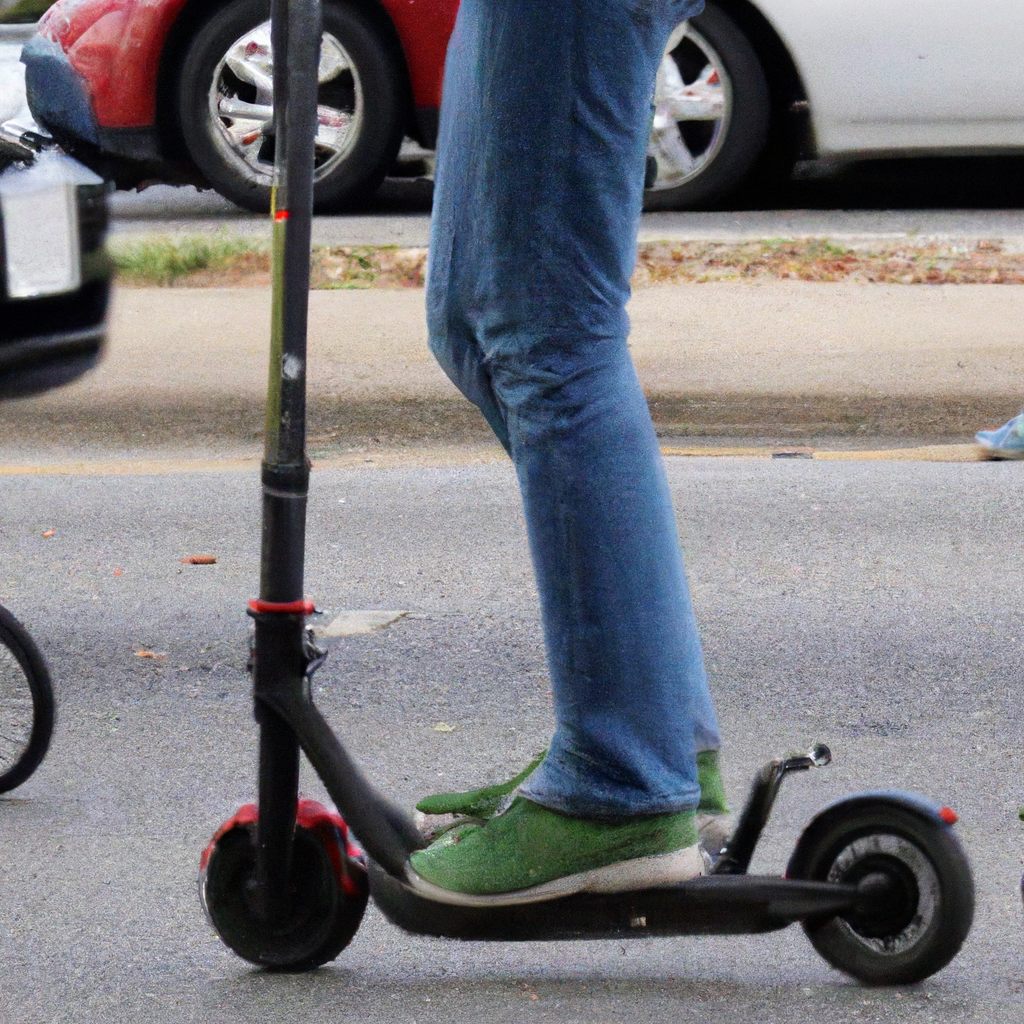So you’ve probably noticed them zipping around town, effortlessly maneuvering through traffic and avoiding the hassle of parking. Electric scooters have become a popular mode of transportation in many cities, offering a convenient and eco-friendly alternative to cars and bicycles. But amidst the buzz, concerns have arisen about their safety. From collisions with pedestrians to accidents caused by inexperienced riders, it’s essential to address the potential risks associated with electric scooters and explore measures to ensure their use remains as safe as possible.
I. Overview of Electric Scooters
A. Introduction to electric scooters
Electric scooters have become a popular mode of transportation in urban areas. These compact and eco-friendly vehicles are powered by electricity, making them an attractive alternative to traditional scooters or cars. With their ease of use and convenience, electric scooters offer a practical solution for short distance travel.
B. Popularity of electric scooters
Over the years, electric scooters have gained immense popularity among commuters and enthusiasts alike. Their compact size and portability make them a favored choice for navigating crowded city streets and avoiding traffic jams. Electric scooters have also been embraced by students, tourists, and individuals seeking a cost-effective and sustainable means of transportation.
C. Key features of electric scooters
Electric scooters come with a variety of features that enhance their functionality and user experience. These features include a lightweight and durable frame, adjustable handlebars, a comfortable riding position, and a reliable electric motor. Additionally, many electric scooters are equipped with headlights, taillights, and brake lights, ensuring visibility and safety even during low-light conditions.
II. Safety Regulations and Standards
A. Government regulations for electric scooters
To ensure the safe operation of electric scooters, government agencies have implemented regulations and laws. These regulations may vary depending on the jurisdiction, but commonly encompass speed limits, age restrictions, and helmet requirements. It is important for riders to familiarize themselves with the specific regulations in their area to avoid legal complications and ensure their safety.
B. Safety standards for electric scooters
Electric scooters are subject to safety standards established by various organizations, such as the International Electrotechnical Commission (IEC) and the Consumer Product Safety Commission (CPSC). These standards cover aspects such as electrical safety, mechanical strength, and overall product performance. Manufacturers must adhere to these standards to ensure that their electric scooters are safe for consumer use.
C. Compliance with safety regulations
It is crucial for electric scooter manufacturers to comply with safety regulations and standards to ensure that their products meet the necessary safety requirements. By conforming to these regulations, manufacturers can provide riders with peace of mind knowing that their electric scooters have undergone rigorous testing and adhere to established safety guidelines.

III. Common Safety Concerns
A. Impact of electric scooter accidents
Despite their growing popularity, electric scooters have raised concerns about safety. Accidents involving electric scooters can result in injuries and sometimes even fatalities. It is important to address these concerns and mitigate the risks associated with electric scooter usage through proper safety education and regulatory measures.
B. Potential risks and hazards
Electric scooter riders face potential risks and hazards that may compromise their safety. These risks include collisions with pedestrians, vehicles, or stationary objects, as well as accidents resulting from mechanical failures or inadequate maintenance. It is essential for riders to be aware of and take precautions to minimize these risks and ensure their safety.
C. Pedestrian safety concerns
The presence of electric scooters on sidewalks and pedestrian areas has raised concerns about pedestrian safety. The speed and maneuverability of electric scooters can pose a risk to pedestrians, especially in crowded areas. It is important for riders to prioritize the safety of pedestrians by adhering to speed limits, exercising caution, and avoiding pedestrian-heavy areas whenever possible.
IV. Electric Scooter Design and Engineering
A. Stability and maneuverability
The stability and maneuverability of electric scooters play crucial roles in ensuring rider safety. Electric scooters should be designed with a low center of gravity and a wide wheelbase to enhance stability. Additionally, they should have responsive steering and braking systems, allowing riders to navigate through various terrains and situations safely.
B. Braking systems
Efficient and reliable braking systems are vital for electric scooter safety. Electric scooters commonly use either mechanical disc brakes or regenerative braking systems. Mechanical disc brakes provide reliable stopping power, while regenerative braking systems harness the energy from braking to recharge the scooter’s battery. Manufacturers should prioritize the development and implementation of effective braking systems to minimize accidents caused by braking failures.
C. Battery safety
The battery is a crucial component of an electric scooter and requires careful attention to ensure safety. Electric scooters should be equipped with high-quality batteries that undergo rigorous testing and meet safety standards. Additionally, manufacturers should provide clear instructions on battery charging and maintenance to avoid potential risks, such as overheating, short circuits, and fires.

V. User Behavior and Safety Practices
A. Importance of user education
Proper user education is paramount to ensuring the safety of electric scooter riders. Users should be familiarized with the operation and controls of electric scooters, as well as the relevant safety regulations and guidelines. Education programs and campaigns can help promote responsible and safe riding practices, reducing the likelihood of accidents and injuries.
B. Protective gear and clothing
Wearing appropriate protective gear and clothing is essential for electric scooter riders. Riders should always wear a helmet to protect the head in the event of a fall or collision. Additionally, wearing knee pads, elbow pads, and sturdy footwear can help prevent injuries to other vulnerable areas of the body. Reflective clothing or accessories can also improve visibility, especially during nighttime rides.
C. Responsible riding practices
Adhering to responsible riding practices is crucial for maintaining safety on electric scooters. Riders should obey traffic laws and regulations, including speed limits and right-of-way rules. It is important to stay vigilant, avoid distractions (such as phone usage), and anticipate potential hazards on the road. By riding responsibly, riders can minimize the risk of accidents and promote a safer environment for themselves and others.
VI. Maintenance and Inspection
A. Regular maintenance checks
Regular maintenance checks are essential to ensure the continued safety and performance of electric scooters. Riders should inspect their electric scooter regularly, checking for potential issues such as loose bolts, worn-out tires, or damaged components. Regular maintenance includes cleaning the scooter, lubricating moving parts, and ensuring all electrical connections are secure.
B. Importance of timely repairs
Timely repairs are crucial for addressing any issues or damages that may compromise the safety of the electric scooter. Riders should promptly seek professional repairs or maintenance services if they notice any unusual noises, vibrations, or performance issues. Neglecting repairs can increase the risk of accidents and cause further damage to the scooter.
C. Inspection and servicing guidelines
Electric scooter manufacturers often provide guidelines for inspection and servicing, which should be followed by owners to maintain safety. These guidelines may include recommendations for specific parts replacement intervals, battery maintenance, and overall inspection procedures. By adhering to these guidelines, riders can ensure that their electric scooters are in optimal condition and operate safely.

VII. Safety Concerns in Urban Environments
A. Sharing the road with other vehicles
Electric scooter riders need to navigate urban environments safely, sharing the road with other vehicles. Riders should familiarize themselves with local traffic laws and behave as responsible road users. This includes signaling turns, yielding to pedestrians, and maintaining a safe distance from other vehicles. By being mindful of other road users, electric scooter riders can reduce the risk of accidents and promote harmonious coexistence.
B. Riding in bike lanes or on sidewalks
Different regions have varying rules regarding where electric scooters are permitted to ride. In some areas, electric scooters are allowed in bike lanes while prohibited on sidewalks. Riders should familiarize themselves with these regulations and ride in designated areas accordingly. It is important to respect the rights and safety of pedestrians and cyclists, and to only ride in permitted areas to avoid potential conflicts or accidents.
C. Proper parking and storage
Proper parking and storage of electric scooters are essential for maintaining public safety and accessibility. Riders should follow local guidelines for parking their electric scooters, ensuring that they do not obstruct sidewalks or entrances. Parking in designated areas or scooter-sharing zones helps minimize congestion and ensures that electric scooters are safely stored when not in use.
VIII. Safety Measures Implemented by Scooter Companies
A. Speed restrictions and control
Many electric scooter companies have implemented speed restrictions and control systems to enhance rider safety. These limitations can help prevent accidents caused by excessive speeds. By capping the maximum speed of electric scooters and incorporating speed control mechanisms, these companies prioritize the safety of their riders and the communities they operate in.
B. GPS tracking and geofencing
GPS tracking and geofencing technologies have been adopted by scooter companies to enforce safe riding practices. These technologies enable companies to monitor scooter usage, track rider movements, and enforce specific boundaries or restricted areas. By implementing GPS tracking and geofencing, scooter companies can deter unsafe behavior and promote responsible riding practices.
C. Reporting and addressing safety issues
Scooter companies often provide mechanisms for riders to report safety issues or concerns they encounter while using their electric scooters. This can include reporting accidents, damaged scooters, or hazards in the riding environment. By promptly addressing these reports, scooter companies can take the necessary actions to mitigate risks, ensuring the ongoing safety and satisfaction of their riders.

IX. Safety Data and Research Studies
A. Analysis of electric scooter accidents
Safety data and research studies on electric scooter accidents play a vital role in understanding and improving scooter safety. By analyzing accident data, researchers can identify common causes and contributing factors to accidents involving electric scooters. This information can then be used to develop targeted safety interventions and improvements in scooter design, infrastructure, and regulations.
B. User surveys and feedback
User surveys and feedback provide valuable insights into the experiences and perceptions of electric scooter riders. By collecting feedback from riders, scooter companies and regulatory bodies can identify potential safety concerns, satisfaction levels with safety measures, and areas for improvement. User surveys and feedback also help shape future safety initiatives and policies to enhance the overall safety of electric scooter usage.
C. Academic and independent research
Academic and independent research studies contribute to the ongoing understanding of electric scooter safety. Researchers investigate various aspects of scooter safety, including rider behavior, infrastructure requirements, and the effectiveness of safety measures. This research enables stakeholders to make evidence-based decisions and recommendations that prioritize the safety of electric scooter riders and the communities they operate in.
X. Conclusion
A. Summary of key safety considerations
Electric scooters provide a convenient and sustainable mode of urban transportation, but they also come with inherent safety concerns. By addressing these concerns through a multifaceted approach, including government regulations, safety standards, user education, and scooter design improvements, the safety of electric scooters can be maximized.
B. Future improvements and advancements
As electric scooters continue to evolve, ongoing advancements in design, engineering, and safety features are anticipated. Manufacturers should prioritize safety in their product development, incorporating innovative technologies and materials to enhance stability, braking systems, and battery safety.
C. Importance of public awareness
Public awareness regarding electric scooter safety is crucial for fostering a safe and harmonious urban environment. Education campaigns, user feedback, and safety measures implemented by scooter companies are all vital components of promoting responsible riding practices. By working together, riders, manufacturers, governments, and communities can ensure that electric scooters remain a safe and sustainable mode of transportation for years to come.




